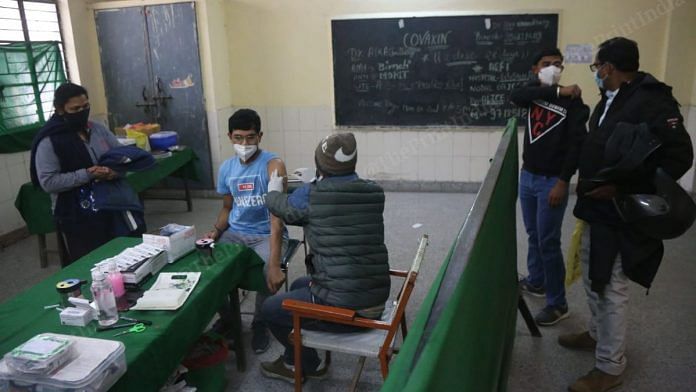New Delhi: After weeks of speculation, the central government Wednesday clarified that the precautionary vaccine dose that will start being given to healthcare and frontline workers and senior citizens with comorbidities after 10 January will be of the same vaccine as the first two shots.
The precaution dose will be given subject to the person having completed nine months since receiving the second dose of the vaccine.
“Precautionary vaccine dose to healthcare workers, frontline workers and senior citizens will be of the same vaccine. Those who got Covaxin will get Covaxin and those who got Covishield will get Covishield,” Dr V.K. Paul, member (health) NITI Aayog, said at a press briefing of the Union Health Ministry.
He also added that, according to all indicators, the pandemic is now in a phase of exponential spread that could potentially overwhelm healthcare systems, even if the rate of hospitalisation does turn out to be less than in the second wave driven by the Delta variant of the SARS-CoV-2 virus. Paul also warned against being lulled into a state of complacency by the narrative that the Omicron variant is causing mild illness.
“India’s test positivity was 1.1 per cent on 30 December, now it’s 5 per cent. That’s an exponential spread. Clearly, this is an expanding pandemic. The R value (reproduction value, an indication of how quickly an infection is spreading) is 2.69, which is even higher than the second wave peak of 1.69,” Paul said.
“In Delhi, the hospitalisation rate is about 4 per cent, and it’s about 5 per cent in Mumbai, according to statements of responsible people there. Last year, the typical hospitalisation rate was close to 20 per cent,” he added.
“When cases go up a lot, even a small fraction requiring hospitalisation will be a big number. We have to slow this down. Use masks, observe social distancing. If we don’t, there will be pressure on health services,” he said. “Systems can be overwhelmed. As a pandemic progresses, the old, and people with comorbidities, start getting affected, we cannot take this narrative of ‘mildness’ and become complacent.”
Understanding the behaviour of the variant that was first reported from South Africa in the Indian genotype requires some more study, said joint secretary, Union Ministry of Health & Family Welfare, Lav Agarwal.
Agarwal added that the death of a senior citizen in Udaipur has now been confirmed to have been caused by an infection of the Omicron variant.
Also read: Covid R value in India shoots up to 1.96, highest since the beginning of the pandemic
Safety concerns about Molnupiravir
Even as a number of Indian companies have started manufacturing the antiviral drug Molnupiravir, and it has received approval from the drug controller for use in an emergency situation for Covid, the Indian Council of Medical Research (ICMR) is not yet convinced about its safety.
ICMR Director General Dr Balram Bhargava said, “Molnupiravir has major safety concerns, including mutagenicity, teratogenicity, muscle and bone damage. If this drug is given to a man or a woman, contraception has to be used for three months, as the child conceived during that period may have problems.
“That is why it is not included in the national Covid-19 guidelines. We have had several discussions about this.”
Molnupiravir, originally manufactured by pharma company Merck, had initially made claims of 50 per cent reduction in hospitalisation or death in patients, but that estimate has now been revised to 30 per cent.
‘Need to understand Omicron numbers’
Active cases in the country have risen sharply in the last one week to 2.14 lakh, from 77,000, Luv Agarwal said.
“The surge, especially in the cities, is being driven by Omicron, where it is the predominant circulating strain. A specific RT-PCR kit that can detect it in four hours has been developed. It will augment genome sequencing,” added Bhargava.
Paul, while conceding that the pandemic is spreading very fast, refused to share either the projections for a national surge or the state of hospital preparedness.
“It is true that we had earlier said we can handle a daily surge of 4.5-5 lakh cases. But that was based on the hospitalisation numbers of Delta. We need some more time to understand the numbers for Omicron before we can make a statement about the state of preparedness,” he added.
Maharashtra, West Bengal and Kerala currently account for 32.71 per cent, 11.90 per cent and 9.76 per cent of Covid cases in the country.
(Edited by Saikat Niyogi)
Also read: Delta to Omicron — India needs to avoid Covid complacency in 2022






